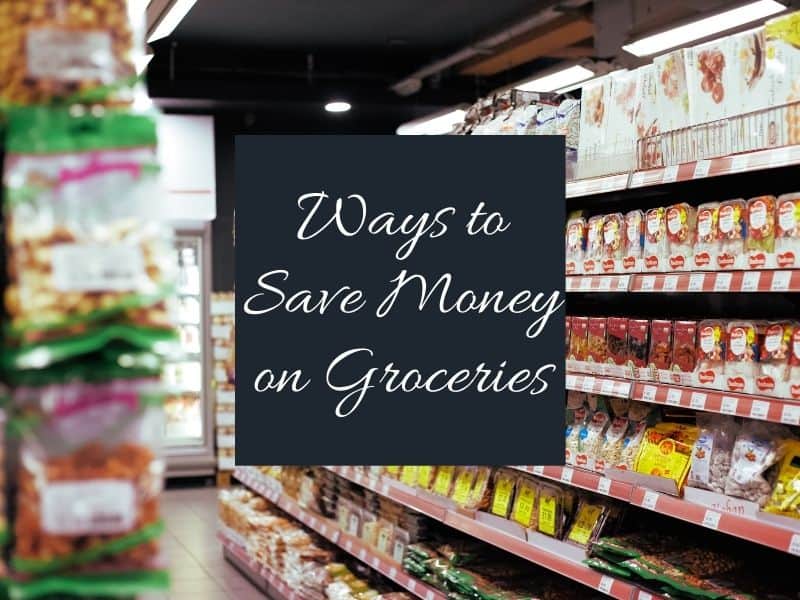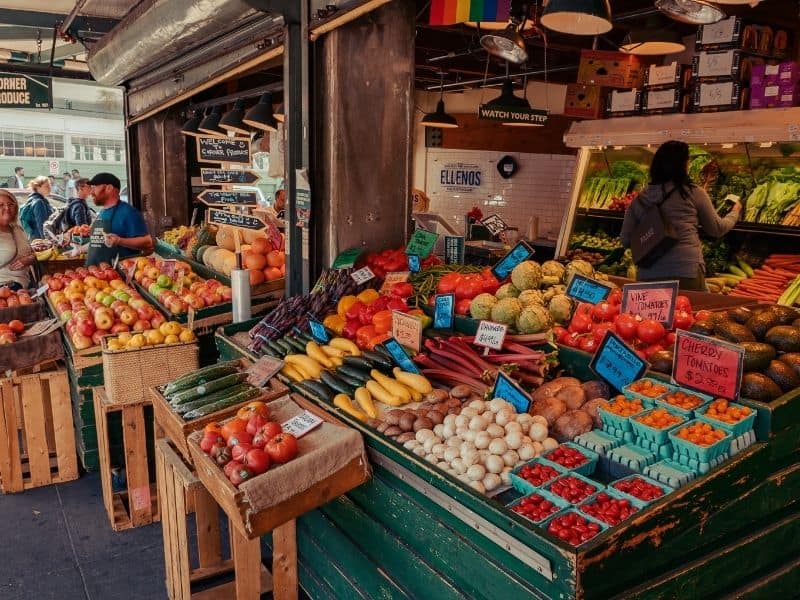Grocery shopping on a budget doesn’t need to be difficult, and you don’t need to go without (unless you’re trying to buy lobster and caviar – you can even get healthy groceries on a budget….) These 9 ways to save money on groceries can help you start saving right away!

This is a guest post from Mario at Hot Kitchen NY. Mario’s goal is to share a passion for cooking with others. Mario writes articles covering all sorts of content on the blog — such as cooking, mouth-watering recipes, and more! Mario agreed to do a guest post on grocery shopping on a budget and how you can save money grocery shopping. Enjoy!
Purchasing groceries can be costly. Keyword: can be. After all, they are a necessity of life, so we’re obligated to buy them.
If you fall into the wrong grocery buying habits, though, it’s possible and even probable to waste thousands of dollars every year.
However, there are excellent ways to avoid this, which is why we’re talking about grocery shopping on a budget. It’s not always about the big picture; instead, it’s the small things that add up and will ultimately save you the most money.
After some time, saving money grocery shopping is going to be an easy task, and you’ll no longer be overspending on items that are otherwise cheaper elsewhere. It may seem like you’re yielding quantity and quality at first, but this isn’t the case. You’re merely shopping smarter.
9 Ways to Save Money on Groceries
1: Use Coupons
The most notable method for saving money on groceries is by using coupons. They’re less commonly used than you may think, which is surprising because they save a lot of money.
You can check out sites such as coupons.com, where you’ll find a coupon for just about any food you could imagine, and more. Just be careful not to get snagged into buying pots or pans instead of food just because they’re half off.
If you play your cards right, though, the cost can be cut by 25% on average — give or take.
2: Buy Off-Brand
It can be tempting to buy your favorite name-brand of food, such as “Jif” peanut butter. Yet, opting to purchase off-brand peanut butter can save you a few dollars.
A name-brand pizza can cost, on average, $7 or more. However, an off-brand pizza can be up to $3 cheaper. It’s not going to skyrocket your savings account overnight, but it will add up over time if you choose to eat off-brand only.
In some cases, off-brands may have a better taste or flavor profile, as they can occasionally contain fewer preservatives, surprisingly enough.
3: Opt for Uncooked Foods
Buying pre-cooked food can add up very quickly. For example, a pre-cooked bag of chicken wings can cost up to $16 or more. However, if you purchase uncooked chicken wings, then you can often buy a dozen for around $8, depending on the area.
Take pancakes, for example; one six-pack box of pre-cooked pancakes will cost about $4. Despite this, a box of pancake powder costs the same yet can make up to 25 full-sized pancakes. You pay for the convenience factor when you purchase pre-cooked foods.

4: Drink Tap Water
Many people purchase bottled water instead of using tap water. It’s not a bad decision, although it’s certainly not the most cost-effective (and it’s terrible for the environment).
Let’s consider the average cost of a 12 pack of 16oz water costing $5; using filtered tap water would save you up to $15 per week. That $15 could be used to buy a few casseroles for the week, or perhaps a couple of off-brand pizzas.
Plus, using tap water would help keep our environment clean by not using plastic water bottles. Instead, you can opt for a reusable aluminum bottle to store the water in.
5: Store Hop
Something that isn’t considered as much as it should be is the price differences between various stores. For example, a carton of cereal may cost $5 at Publix, while the same brand costs $3.50 at Winn-Dixie.
The alternative which may seem more appropriate is to shop at local stores. This isn’t always the best decision to make, though, due to cost-plus or other base price add-ons.
The best way to address this is to find a store around the middle. Walmart is a fine example; although there are better prospects, many are branches, and others are locally owned.

6: Buy Food in Bulk
Buying food every other day may seem like it would save you from overspending. There is a better way to buy groceries, though: buying the food in bulk. By opting to purchase food in bulk, you get more for less. You can also try buying these cheap foods to save money on groceries.
Many big box stores, such as Sam’s Club, sell large boxes of various foods such as macaroni, beans, and meats. You can save big time because, with stores that sell in bulk, you’re paying for 85% of the product, and maybe even less, depending on the store.
Plus, by buying meat in bulk, it’s easy to store long-term, hence our next tip.
7: Vacuum Seal
A handy way to preserve both cooked and uncooked food is by vacuum sealing it. Most food can last anywhere from a few weeks to a few months in the freezer while still retaining its freshness.
Yet, vacuum sealing the food will not only make it last longer but also allows for more food to be stored by shrinking in size due to the air being removed. Moreover, you can cook several meals, vacuum seal them, heat them, and eat them later.
This will allow you to avoid buying pre-cooked food, such as for lunch at work or school, saving you heaps of money.

8: Make A Budget
The most critical component to do before you do anything else is to make a grocery budget. Creating a solid budget plan will ensure that you don’t spend more than you can afford.
Furthermore, a budget will help you figure out what you don’t need. It’s best to make a monthly budget plan, breaking it down into weekly sections. You can do this as part of your cash envelope system.
You should try to eliminate anything unnecessary and give the budget a little wiggle room if feasible. If you have any left, then cache it for a rainy-day fund instead of spending it on extra food you may not actually need.

9: Shop at Farmers Markets
Finally, pay a visit to a local farmers market near you. By shopping at big box stores, prices are already increased by the middleman. However, purchasing your food from a farmers market means there is no middle man, which may result in much lower prices overall.
Farmers’ markets are famous for their locally grown fruits, vegetables, and meats. Often, the food is free of pesticides and antibiotics, resulting in much healthier food. Shopping at the farmers’ market supports your local community’s economy as well, which is a very nice bonus.
You may also like cheap food to buy when you’re’ broke.
Takeaway
I know we’ve all been astounded by glancing at the receipt after shopping for groceries at some point. By merely changing your shopping habits, you can save a substantial amount of money.
It doesn’t have to be challenging to transition into grocery shopping on a budget; after a few months, it should become second nature. Remember, you’re not sacrificing food — you’re just changing the way you shop; by opting for more while spending less money. Who would have imagined?
What are some of the ways you save money on groceries? Comment below and let us know!
[ad_2]
Source link
